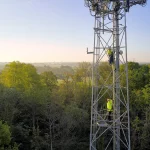ITU Hands Future 5G Mobile Broadband Tech a Target Speed of 20Gbps
The International Telecommunication Union has put a lid on the debate over the peak performance capabilities of future 5G (IMT-2020) based Mobile Broadband technology by defining its top speed as 20Gbps (Gigabits per second), which is 20 times faster than the 4G (IMT-Advanced) rate of 1Gbps.
At this point it’s worth remembering that, in order to qualify as a true 4G service (using LTE-Advanced or WiMAX2 connectivity), mobile operators need to support peak data speeds of up to approximately 100Mbps (Megabits per second) in a high mobility multi-user environment (e.g. mobile phones) and up to 1000Mbps (1Gbps) in a low mobility one (e.g. local wireless access).
Advertisement
In reality most operators initially adopted first generation LTE technology, which by the ITU’s rule should be more akin to 3G than 4G, and ended up calling it 4G anyway because the marketing people have all the real power. Even today the best peak rate that you can get from EE’s 4G (LTE-Advanced) network is 403Mbps and that has yet to be deployed beyond Wembley Stadium (here).
Never the less the standard is still important because it sets a clear benchmark for all the players to target and helps to foster a more harmonised approach. Officially the ITU began this process last month after they established the first Focus Group to define a standard for 5G (here) and this month they’ve started to define the overall technology goals and roadmap.
The bad news is that those hoping for 5G to have a peak data speed of 50Gbps or even 100Gbps, which didn’t seem very feasible, will be left disappointed by the decision to go with 20Gbps. On top of that 5G networks must also be able to provide performance of 100Mbps+ (average data transmission speed) to over 1 million Internet of Things (IoT) devices within 1 square kilometre (seems rather challenging given the need for an extensive ultra-capacity fibre optic backhaul network).
Houlin Zhao, ITU Secretary-General, said:
“The buzz in the industry on future steps in mobile technology – 5G – has seen a sharp increase, with attention now focused on enabling a seamlessly connected society in the 2020 timeframe and beyond that brings together people along with things, data, applications, transport systems and cities in a smart networked communications environment.
ITU will continue its partnership with the global mobile industry and governmental bodies to bring IMT-2020 to realization.”
But setting a target is the easy part, while the next stage of establishing detailed technical performance requirements for the radio systems needed to support 5G will be a lot harder. As a technology 5G must operate in both the familiar low frequency bands (e.g. 800MHz to 2.6GHz) and be able to harness the performance of higher frequency ranges (e.g. 6GHz to 100GHz) for ultrafast speeds.
Advertisement
The UK telecoms regulator, Ofcom, has already identified some candidate radio spectrum bands for 5G usage (here), yet getting other countries around the world to agree is always a rather more challenging prospect and often results in some fragmentation (e.g. different countries using slightly different bands).
Under the current plans the ITU will expect that any identified radio spectrum should have been released by national regulators in time for 2019 and the first commercial deployments would then be expected to follow in 2020, although we wouldn’t be surprised to see this slip into 2021/22. The current date is dependent upon everything going to plan and how often does that happen?
The ITU-R (Radio Communication) Assembly will next meet in October 2015, when it is expected to formally adopt the term IMT-2020 for 5G networks.
Mark is a professional technology writer, IT consultant and computer engineer from Dorset (England), he also founded ISPreview in 1999 and enjoys analysing the latest telecoms and broadband developments. Find me on X (Twitter), Mastodon, Facebook, BlueSky, Threads.net and Linkedin.
« Vodafone UK’s Rural Open Sure Signal Brings 3G Mobile to Broad Chalke

















































Comments are closed